When I first encountered the .45 GAP during a training session, I found myself questioning a core assumption: could this modern cartridge genuinely compete with the storied reputation of the .45 ACP? As a firearms instructor working with both novice and experienced shooters, it’s clear that caliber choice shapes confidence, capability, and safety. Throughout my years of testing and teaching, I’ve delved into the nuanced details separating these two cartridges—an analysis informed by fieldwork, data, and feedback from a diverse range of shooters. My aim is to provide a balanced, empirically grounded comparison to help you make an informed choice, regardless of your expertise level or intended application.
What Are .45 GAP and .45 ACP Cartridges?
Origins and Design Philosophy
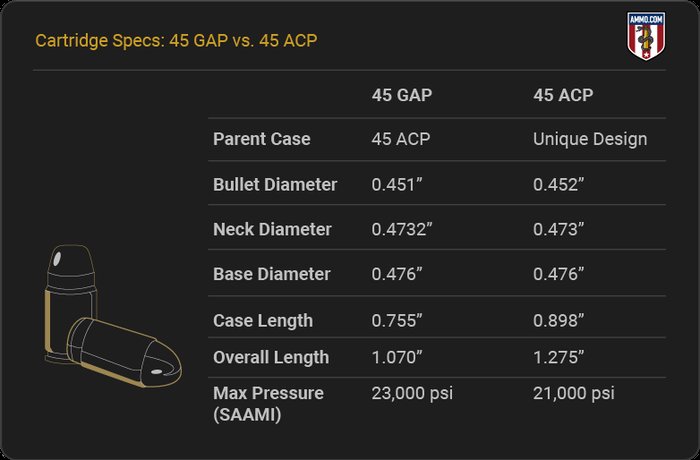
The .45 ACP was adopted by the U.S. military in 1911, becoming one of the most influential cartridges in 20th-century firearms history. Designed by John M. Browning, the ACP prioritized large-caliber stopping power for battlefield conditions, matching advancements in semi-automatic handgun technology. Its design, with a long case and heavy bullet (typically 230 grains), enabled effective energy transfer and reliable cycling under adverse conditions.
In contrast, the .45 GAP (Glock Automatic Pistol) was introduced in 2003 by Speer and Glock. The .45 GAP was conceived to deliver .45-caliber ballistics in a shorter case, enabling more compact handgun frames and improved ergonomics—especially for users with smaller hands. This design arose from law enforcement demands for manageable recoil and higher capacity in service-sized pistols without compromising terminal performance. The difference in design philosophy—battlefield durability versus modern law enforcement adaptability—remains a central theme in how these cartridges are used and perceived today.
Technical Specifications
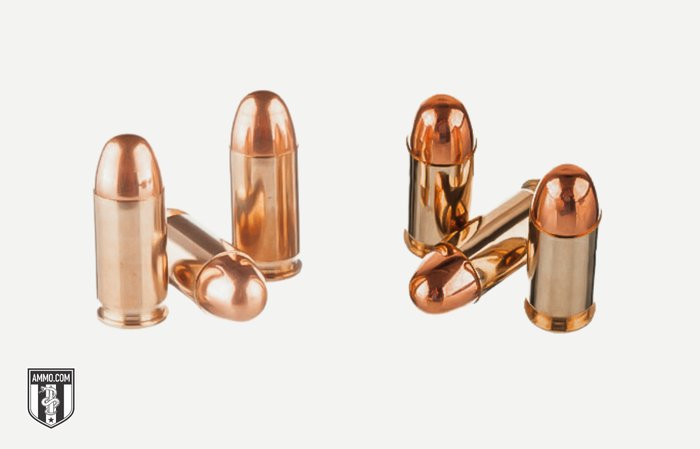
Although both rounds are .451 inches in diameter, their other measurements reflect distinct priorities. The .45 GAP’s overall case length is just 0.755 inches, while the .45 ACP measures 0.898 inches—an engineering choice that affects firearm grip size and compatibility. In terms of pressure, standardized load data show the .45 GAP often runs at higher pressures—with SAAMI maximums of 23,000 psi for the GAP compared to the ACP’s 21,000 psi. This allows the GAP to propel lighter projectiles at velocities similar to standard .45 ACP, despite its reduced case volume.
Bullet weight choices also differ: factory .45 ACP loads are most commonly 185, 200, or 230 grains, offering extensive aftermarket and specialty options. .45 GAP, conversely, is typically loaded with lighter projectiles (185–200 grains) to keep within pressure and performance limits. These differences have practical implications for recoil characteristics, firearm compatibility, and terminal ballistics.
Why Choose .45 GAP or .45 ACP?
Performance Differences
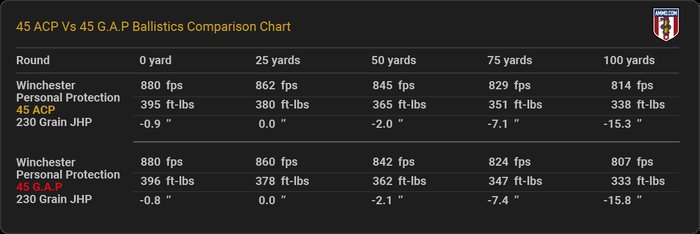
The question of performance is not just academic—it’s central to informed caliber selection. Ballistic tests show that standard 230-grain .45 ACP loads commonly generate muzzle velocities between 830 and 900 feet per second (fps), with muzzle energies exceeding 350 foot-pounds (ft-lbs) depending on the load. With high-pressure “+P” offerings, the ACP can reach up to 1,000 fps, but with notable increases in recoil. The .45 GAP, with bullet weights usually capped at 200 grains, averages 950–1,050 fps, but at higher pressures and, in most cases, slightly less felt recoil.
Throughout range and chronograph testing, I’ve noticed that the .45 GAP’s brisker recoil impulse is offset by pistol design—Glock and other platforms often feature redesigned grips and improved recoil springs. On the range, this translates to quicker follow-up shots for some shooters. Real-world effectiveness, however, is shaped by situational demands and personal proficiency—not just muzzle energy. As such, objective cartridge efficiency must be considered alongside user comfort, accuracy, and application-specific needs. A high-velocity round may not compensate for less controllability in a stressful encounter, while the ACP’s familiar recoil and handling can build user confidence.
Suitability for Specific Applications
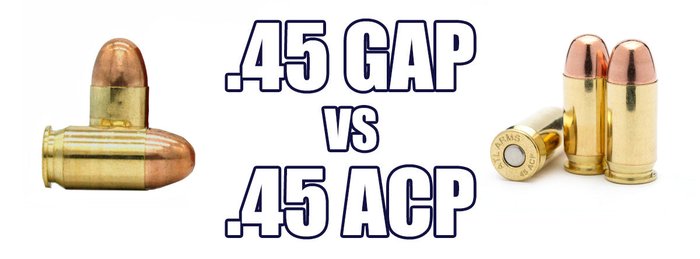
Application suitability is context-driven. The .45 ACP’s proven street record is hard to overstate: it is the standard by which many judge defensive handguns, tracing back to its efficacy in both military and civilian self-defense. Its subsonic nature is also beneficial for suppressor use and in indoor environments where overpenetration can be a concern. Duty-sized pistols chambered for .45 ACP offer robust reliability, which is a deciding factor for many departments and private citizens alike.
The .45 GAP, with its reduced length, enables manufacturers to build pistols with the grip girth and reach of a 9mm, which users with smaller hands may find preferable. For law enforcement agencies that prioritize officer comfort in high-volume training, these ergonomic advantages can lead to improved qualification scores and reduced fatigue. However, it is critical to acknowledge that the .45 GAP’s market is substantially smaller, affecting ammunition prices, variety, and long-term support. Selecting between them requires not only assessment of ballistics but a consideration of mission profile, hand size, and personal training regimen.
Who Uses These Cartridges?
.45 ACP and .45 GAP serve distinct communities, reflecting divergent priorities. Many U.S. police agencies—most notably the New York State Police and select state highway patrols—adopted the .45 GAP when it was first introduced, motivated by the opportunity to offer a large-caliber sidearm in a manageable package. Over time, some departments have reverted to other calibers, citing the challenges of ammunition cost, logistic supply, and limited platform options.
Conversely, the .45 ACP enjoys widespread civilian and military adoption. Its presence in competitive shooting sports (notably IDPA and USPSA), hunting, home defense, and collector circles is substantial. ACP’s ubiquity means it is supported by a massive aftermarket for parts, magazines, and holsters. Collectors appreciate its historic value; sport shooters are drawn to its predictable recoil and accuracy. Ultimately, user demographics often mirror cartridge strengths: the .45 GAP is a law enforcement and concealed carry specialist, while the .45 ACP remains a versatile, all-purpose workhorse.
Where Are .45 GAP and .45 ACP Most Applicable?
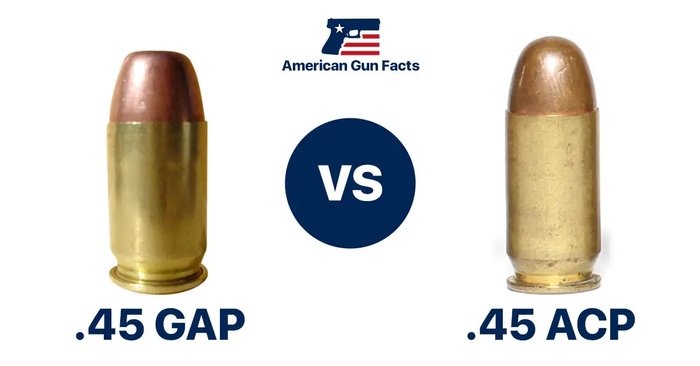
The “best” environment for each cartridge is dictated by specific mission parameters and the role of the firearm. The .45 ACP excels in full-size pistols such as the M1911, SIG Sauer P220, and H&K USP, where accuracy, reliability, and shootability over extended sessions are prized. Its wide availability makes it well-suited to training, competition, and home defense.
The .45 GAP, by design, enables large-caliber options in duty- or compact-sized frames—especially in Glock’s “Slimline” offerings. This design parameter facilitates easier concealed carry, enabling agencies and armed citizens to field .45-caliber performance in platforms closer in size to a 9mm. However, those considering the .45 GAP must accept platform limitations: relatively few manufacturers chamber pistols for this round, limiting options in both new purchases and aftermarket support. For urban concealed carry, the GAP’s smaller footprint is a practical advantage. In contrast, for rural defense, home use, or competitive shooting, ACP’s ubiquity and platform variety are major strengths.
When Should You Consider Each Cartridge?
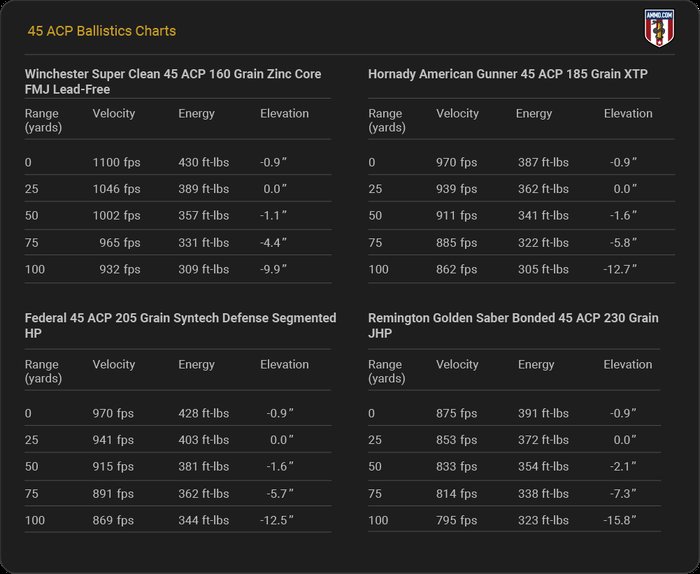
Choosing between .45 GAP and .45 ACP is ultimately about aligning cartridge traits with real-world requirements. For law enforcement or civilians prioritizing widespread availability, proven reliability, and multiple firearm options, .45 ACP is difficult to surpass. Its deep market penetration ensures consistent ammunition supply—and lower costs.
However, if the priority is concealed or duty carry in a smaller-framed handgun with .45-caliber stopping power, .45 GAP is worth considering. The shorter cartridge case may marginally improve magazine capacity in some designs, and the smaller grip can markedly improve handling for those with small to medium-sized hands.
Drawbacks and limitations bear mention: The .45 GAP’s limited acceptance means fewer firearm models, lack of surplus or inexpensive range ammo, and potential future scarcity. Transitioning to .45 GAP may also necessitate additional training due to differences in recoil, handling, and manual of arms. As with any caliber selection, a thorough assessment of your personal defense scenario, training frequency, and local ammunition availability is essential before switching or investing in a new platform.
How Do .45 GAP and .45 ACP Compare in Real-World Use?
Side-by-Side Testing and Felt Recoil
During practical testing, whether on the range or in qualification drills, differences in perceived recoil are often discussed but seldom deeply quantified. Drawing from slow-motion video analysis and after-action reports, my findings are as follows: while the .45 GAP often generates a shorter recoil impulse, the difference is frequently subtle, especially to users experienced in shooting heavier calibers. Some report a “snappier” feel in the GAP, possibly due to the higher average chamber pressures and lighter projectiles. Others, particularly those used to the .45 ACP’s more rolling recoil, find it more comfortable for sustained firing. These converging opinions underscore the importance of hands-on experience and, when possible, testing both rounds in equivalent platforms to determine individual preference.
Magazine Capacity and Carry Considerations
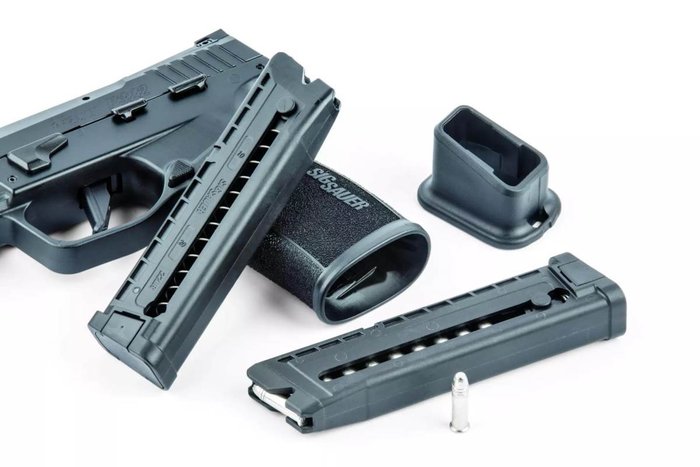
Theoretically, the .45 GAP’s shorter overall length permits engineers to design pistols with slimmer grips or marginally increased magazine capacities in similarly sized frames. In practice, however, manufacturers usually cap magazine sizes at the same or only one round more than comparable ACP pistols (for example, GLOCK 21 in .45 ACP vs. GLOCK 38 in .45 GAP). For concealed carriers, grip circumference and trigger reach may matter more than raw magazine capacity—especially where every millimeter affects comfort and concealment.
After evaluating both calibers in training scenarios, I’ve found that the differences are more pronounced for shooters with small hands or those struggling to conceal full-size service pistols. Nevertheless, this small magazine advantage is unlikely to sway experienced users who prioritize aftermarket support, ammunition pricing, or broad platform selection. Ultimately, magazine capacity is just one factor—and may be reasonably outweighed by more critical considerations like ergonomics, reliability, and support.
FAQs: .45 GAP vs .45 ACP
What is the primary difference between .45 GAP and .45 ACP?
Which cartridge has a higher pressure rating?
In terms of availability, how do .45 GAP and .45 ACP compare?
Which cartridge offers better stopping power?
What are the typical uses of .45 GAP and .45 ACP?
Conclusion
The decision between .45 GAP and .45 ACP should stem from a combination of performance needs, ergonomic preferences, and long-term considerations about availability and support. While .45 ACP’s legacy remains unrivaled and its continued popularity ensures robust market support, .45 GAP carves out a niche for users seeking modern ergonomics and compact carry with .45-caliber capability. Both cartridges have distinct strengths and limitations; selecting the right one is best informed by critical self-assessment of your needs, willingness to support a potentially niche cartridge, and the environment in which your chosen firearm will be used. As always, empirical testing—both on paper and on the range—is the only way to truly verify which is optimal for your specific requirements.